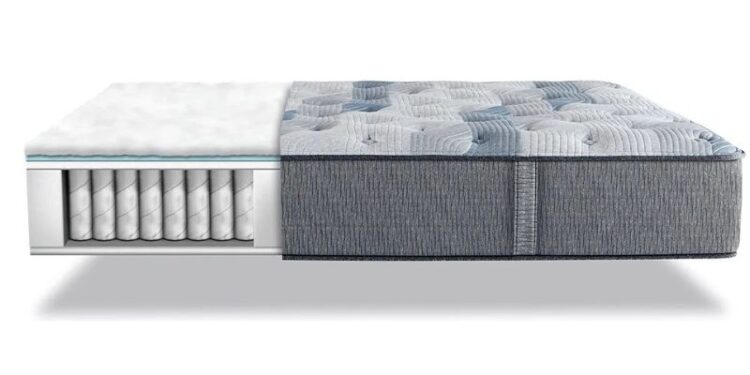There are numerous choices on the market when it comes to selecting the appropriate mattress. Hybrid and traditional mattresses are two popular choices that frequently cause buyers confusion. To assist you in making an educated decision, we will examine “What is the Difference Between a Hybrid Mattress and a Traditional Mattress?” in this article. So, let’s get started and learn what distinguishes a hybrid mattress from a conventional one.
What is the Difference Between a Hybrid Mattress and a Traditional Mattress?
Hybrid Mattress
A hybrid mattress combines the benefits of both innerspring mattresses and memory foam mattresses. It typically consists of a supportive coil system as the base layer, topped with layers of foam or latex for enhanced comfort and pressure relief. The goal of a hybrid mattress is to provide a balanced sleep experience by combining the traditional support of an innerspring mattress with the contouring comfort of foam or latex.
Traditional Mattress
A traditional mattress, also known as an innerspring mattress, is constructed with a core support system of metal coils or springs. These coils provide the primary support and durability of the mattress. Traditionally, these mattresses have been popular due to their affordability, bounce, and breathability. However, advancements in mattress technology have introduced new options like hybrid mattresses that cater to specific sleep preferences.
The Differences Between a Hybrid Mattress and a Traditional Mattress
To understand the distinctions between hybrid mattresses and traditional mattresses, let’s explore their differences under various aspects:
Construction
Hybrid Mattress:
- Typically consists of a coil support system as the base layer.
- Features multiple layers of foam or latex for comfort and pressure relief.
- May include specialized materials like gel-infused foam for cooling or copper-infused foam for added support and antimicrobial properties.
Traditional Mattress:
- Comprises a coil support system as the main component.
- Often features a thin layer of padding on top for added comfort.
- May include pillow tops or Euro tops for additional cushioning.
Support
Hybrid Mattress:
- Offers a combination of support from the coil system and contouring comfort from the foam or latex layers.
- Provides better weight distribution and pressure relief, making it suitable for various sleep positions.
- Ideal for individuals who prefer a balanced feel and need both support and cushioning.
Traditional Mattress:
- Relies primarily on the coil system for support.
- Offers a more pronounced bounce and a firmer feel.
- Suitable for individuals who prefer a traditional, supportive feel and enjoy the responsiveness of a spring mattress.
Motion Isolation
Hybrid Mattress:
- Generally provides better motion isolation compared to traditional mattresses.
- The foam or latex layers absorb motion, reducing disturbances caused by a restless sleep partner.
- Suitable for couples or light sleepers who are easily disturbed by movements on the bed.
Traditional Mattress:
- Offers less motion isolation due to the bounciness of the coil system.
- Movements on one side of the bed can be felt on the other side.
- May not be the best choice for individuals who are sensitive to motion transfer during sleep.
Temperature Regulation
Hybrid Mattress:
- The combination of foam or latex layers and coil support allows for better airflow and heat dissipation.
- Some hybrid mattresses incorporate cooling technologies like gel-infused foam or phase-change materials to enhance temperature regulation.
- Suitable for individuals who tend to sleep hot or live in warmer climates.
Traditional Mattress:
- The coil system in traditional mattresses allows for more airflow, promoting better breathability.
- Does not have specialized cooling features like gel-infused foam.
- Can be suitable for individuals who prefer a cooler sleep surface without additional cooling technologies.
Frequently Asked Questions (FAQs)
Q: Are hybrid mattresses more expensive than traditional mattresses?
A: Hybrid mattresses tend to be more expensive due to their advanced construction and use of premium materials. However, the price can vary depending on the brand, features, and quality of the mattress.
Q: Which type of mattress is better for back pain, a hybrid or a traditional mattress?
A: Both hybrid and traditional mattresses can provide adequate support for individuals with back pain. However, hybrid mattresses with their combination of coil support and foam or latex layers often offer better contouring and pressure relief, which can alleviate back pain.
Q: Do hybrid mattresses last longer than traditional mattresses?
A: The lifespan of a mattress depends on various factors, including the quality of materials and construction. Generally, hybrid mattresses are designed to be durable and long-lasting, but there are traditional mattresses available that can also offer excellent longevity.
Q: Can I use a hybrid mattress on an adjustable bed frame?
A: Yes, many hybrid mattresses are compatible with adjustable bed frames. However, it’s essential to check the manufacturer’s recommendations and ensure that the mattress can flex and bend without damaging its structure.
Q: Do hybrid mattresses have a chemical smell?
A: Like any new mattress, hybrid mattresses may have a slight odor initially due to off-gassing. However, this odor typically dissipates within a few days, especially if the mattress is well-ventilated.
Q: Can I try a hybrid mattress before buying?
A: Many mattress brands offer trial periods during which you can try the mattress in your own home and decide if it meets your sleep needs. Be sure to check the return policy and warranty details before making a purchase.
Conclusion
In summary, the difference between a hybrid mattress and a traditional mattress lies in their construction, support, motion isolation, and temperature regulation capabilities. Hybrid mattresses combine the best features of innerspring and foam mattresses to offer a balanced sleep experience, while traditional mattresses rely primarily on coil support for a more traditional feel.
Understanding these differences can help you choose the mattress that suits your individual preferences and sleep needs.

